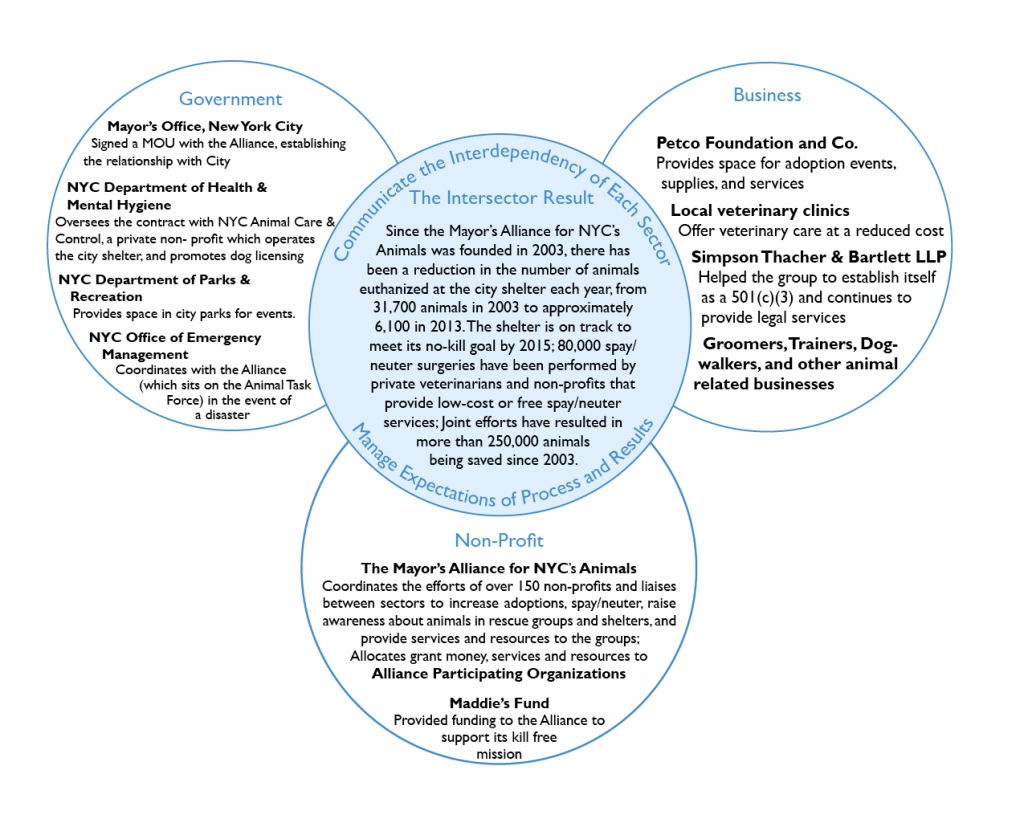In the early 2000s, tens of thousands of animals were euthanized each year in New York City shelters due to a lack of awareness of the adoptable animals available in shelters and rescue groups. Many such groups worked independently to find homes for these animals, but a lack of communication and coordination between the groups, the City shelter, and the City hindered their efforts. When Mayor Michael Bloomberg took office in 2002, Jane Hoffman, one of the founding members of the New York City Bar Association’s Animal Law Committee, co-wrote a memo highlighting challenges faced by the city shelter and asked for collaboration with the City government. Her memo began an ongoing cooperation with the City, and the creation of the Mayor’s Alliance for NYC’s Animals, a private non-profit. The Alliance applied for and was granted funds by an animal welfare foundation, Maddie’s Fund, which initially promised the Alliance $15 million and has provided approximately $30 million since 2005. The Alliance provides services and resources to coordinate and enhance the rescue efforts of more than 150 animal rescue groups, city departments, and private companies like Petco. Since 2003, their collaborative efforts have resulted in saving more than 250,000 dog and cats in New York City.

Saving Shelter Animals in New York City
About This Project

“No one animal welfare organization could solve this problem if we didn’t have the involvement of the government, private sector, and the public.”— Jane Hoffman, President, Mayor’s Alliance for NYC’s Animals
Download this case study »
Before founding the Mayor’s Alliance for NYC’s Animals, Jane worked as an attorney for the law firm Simpson, Thatcher & Bartlett, and as a management consultant. Her experience analyzing company operations in order to determine better business practices, as well as her ability to create strategic plans for organizations, have helped her guide the collaborative efforts of the Mayor’s Alliance for NYC’s Animals.

Transferable Skills
Jane’s legal education, career, and work as a management consultant helped her navigate city government bureaucracy, promote professional conduct from Alliance participants, seek funding sources, and communicate effectively with business partners, such as local veterinarians, animal-related service providers such as groomers and trainers, and Petco. Jane credits her ability to create a strategic plan, a step crucial in obtaining the necessary funding from Maddie’s Fund, the California-based non-profit organization which has provided approximately $30 million of dollars to support the Alliance’s efforts thus far. Her negotiation skills proved helpful in recruiting city government to cooperate. Jane put together a strategic plan from a business-world perspective; she saw this business-oriented mindset lacking in the non-profit sector, and believes this knowledge gave her an advantage in thinking strategically of the Alliance’s goals and how to achieve them.

Contextual Intelligence
Jane’s experience as an attorney taught her the language and needs of each sector, helping her communicate with government and business officials effectively. For example, she conveyed to Petco and veterinarians how working with the Alliance would increase their profits by boosting their reputation for compassion and by bringing more customers to the business. By highlighting the financial incentives for cross-sector efforts, she ensures that the more than 150 non-profit organizations can work not only with each other but also with city government and businesses. She stresses the importance of “thinking like businesses” and increasing the professionalism of non-profits without losing focus of the goal to help animals. Jane now teaches how to execute strategic plans across sectors at conferences, seminars for the ASPCA and the Alliance, and webinars for the Humane Society of the United States and Petsmart Charities.

Integrated Networks
Jane’s network proved to be a crucial resource in establishing the Alliance; she tapped contacts in the business and legal community for a variety of services. Her contacts at the consulting firm McKinsey & Co. helped her to compose a strategic plan, while her former law firm Simpson, Thatcher & Bartlett helped the Alliance establish itself as a non-profit. The firm continues to serve as the Alliance’s legal counsel. Similarly, the General Counsel of the New York City Bar Association supported Jane during early meetings with city government officials, providing further legitimacy to her efforts; Jane was a founding member and past chair of the Animal Law Committee of the Bar Association.

Intellectual Thread
Jane’s legal education and expertise helped her to overcome bureaucratic roadblocks in city government, and ensure confidentiality with partners when necessary. Jane recognized that Mayor Bloomberg supported cross-sector partnerships, so she positioned the Alliance as a political necessity, selling the Alliance as a business deal rather than simply a cause. As an attorney, Jane learned how to mediate between various stakeholders in order to come to a mutually beneficial conclusion.

Commit to information sharing
Maddie’s Fund required the Alliance create a 10-year strategic plan as a condition of funding. The strategic plan has four core objectives: increase awareness, increase adoptions, increase resources, and decrease homelessness. The strategic plan consisted of 18 initiatives including adoption events and the mobile transport service, Wheels of Hope, which were designed to help achieve the four core objectives. The City’s disclosure of overall euthanasia and adoption numbers were important for grant applications and to determining whether goals were being met. Mayor Giuliani’s administration (1994-2001) disclosed numbers that seemed too low to Jane, likely based on a “bunker mentality” of the administration; Jane argued that releasing accurate numbers could be beneficial, and help the Alliance receive more money from Maddie’s Fund. The Alliance also reports adoption numbers for all member groups as a whole, rather than disclosing numbers for each member, to help the members feel comfortable sharing information.

Share a vision of success
The Alliance’s goal is to reduce the number of animals euthanized in the city shelter each year by increasing the number of animals adopted to the public, transferred to rescue partners to assist in getting them adopted, and returned to owners, and increasing the number of spay/neuter surgeries performed. The Mayor’s Alliance promotes a “no kill” New York City by 2015. Petco, which already hosted adoption centers in many of their stores, was naturally amenable to working with the Alliance to create major adoption events. Jane convinced the city to share her vision of success by arguing that it would be good public policy and fiscally responsible for the city to reduce euthanasia. Previously, the city didn’t have a stated goal of reductions in euthanizations; the new administration, she argued, could take corrective action without being blamed politically for an “embarrassingly high number” of euthanized animals in the city shelter.

Recruit a powerful sponsor or champion
Obtaining the support of Maddie’s Fund has been crucial for the operation of the Mayor’s Alliance for NYC’s Animals and its member non-profits. Maddie’s Fund was started by Dave Duffield and his wife Cheryl. Dave is co-CEO of Workday, a successful publicly traded enterprise software firm and his support provided legitimacy to the project. Because the grant from Maddie’s Fund required the Alliance to create strategic direction to qualify for funding, the Fund helped further the Alliance’s mission.

Communicate the interdependency of each sector
It was clear to Jane that ‘no one rescue group or sector could have done it alone,’ and that part of her responsibility was to convey the need for the collaboration to the partners. “One of the challenges,” Jane says, “was getting people to realize that the city shelter wasn’t the enemy.” The non-profits had to work with and not against the city shelter. Private sector veterinarians, animal service related businesses, and pet supply stores understood the value of involvement with the Alliance; for instance Petco has physical locations capable of hosting major adoption events and adoption centers for individual rescue groups and shelters, which in turn provided publicity and increased sales for the company. The major adoption events feature vets, trainers, groomers, and pet supply businesses including pet food companies, offering their services at no cost.

Build a common fact base
It was crucial that Jane persuade the city to provide accurate statistics for the number of animals euthanized at the city shelter, not only to gain the trust of the non-profit organizations involved, but also for the Alliance to receive the appropriate amount of funding from Maddie’s Fund. One of the keys to reducing euthanasia was increasing adoption; the creation of the major adoption events that many of the rescue groups and shelters participated in brought attention to the pets available. Having these events in “happy” locations, such as city parks and stores, engaged the public and motivated them to support the Alliance’s collaborative efforts. Jane said that the city under Mayor Giuliani was taking in over 40,000 animals and reporting only 3,200 adoptable animals. But when the Bloomberg administration took office, Jane saw an opportunity to explain the advantages of reporting accurate numbers, to allow the alliance to secure an even larger grant from Maddie’s Fund, and in turn provide funds to member groups and to help them become more effective and more efficient in their rescue efforts.
Homeless animals in New York City have a much brighter future than they did 10 years as ago as a result of the efforts of the Mayor’s Alliance for NYC’s Animals. Approximately a quarter of a million cats and dogs have been saved since 2003, and the city is on target to be “no kill” by 2015.
- The Alliance continues to host, along with Petco and the city, major adoption events for dogs, cats, and rabbits a few times a year. At these events, the public can learn about available pets or about how they can find low-cost spay/neuter and other services for existing pets. They can also obtain a city dog license and find out more about emergency preparedness for pets from city information booths.
- Maddie’s Fund has contributed approximately $30 million to the Alliance through the Pet Rescue Project in NYC and the Spay/Neuter Project in NYC.
- Jane teaches seminars at conferences, on webinars for the Humane Society of the United States and Petsmart Charities, and for other local non-profits on how to replicate the Alliance model.
